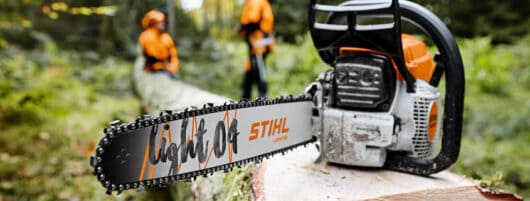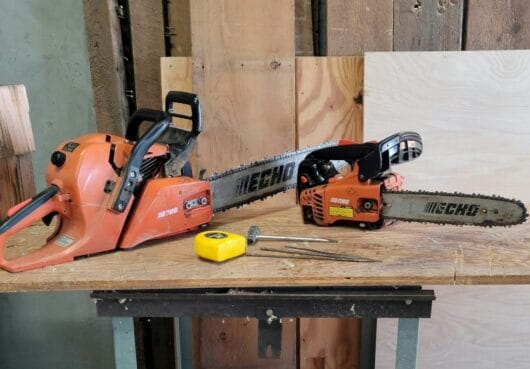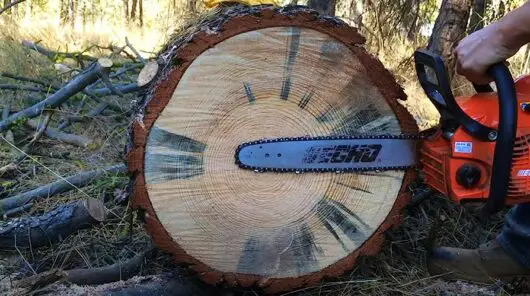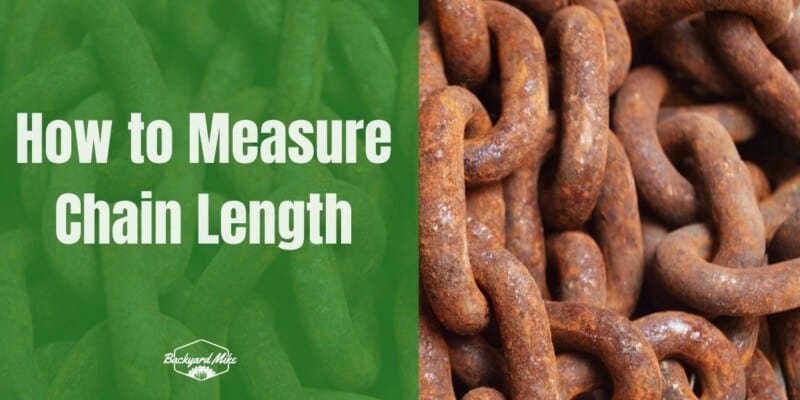Measuring chain length can be a daunting task for any beginner. Knowing how to measure chain length properly is critical for many different applications, such as bike repairs, jewelry making, and more. In this article, we’ll provide a comprehensive guide to different measurement techniques that will help you get the accurate chain length you need. Whether you’re just starting out or an experienced professional, this article will provide all the information you need to measure chain length with confidence. Let’s get started!
Understanding chain length
Whether you’re looking to order replacement chainsaw parts or you’re simply going to buy a new chainsaw with a specific bar length, at some point, you will need to take measurements of your chainsaw. The chain length will be important as it’ll allow you to carry out various processes. Like most tools, chainsaw components are quite easy to measure when you know the right way to measure them.
Definition of chain length
A chainsaw chain is a vital part of the chainsaw that allows it to cut through wood with precision and efficiency. It is made up of a series of sharp teeth that move along the guide bar, and it is important to choose the correct chain length for the chainsaw.
Chainsaw chain length will refer to the distance between the first and last links of a chainsaw chain. It is important for selecting the right chain length for the chainsaw, as it’ll affect the performance and safety of the tool.

Different types of chain length measurements
#1. Overall chain length
The overall chain length is the total length of the chainsaw chain, including the links and the cutting teeth. This measurement is typically listed in inches and is the most common way of measuring the chainsaw chain. For determining the overall chain length, you should measure the distance from the tip of the chainsaw to the starting point. This measurement is important when purchasing a new chainsaw chain to make sure it fits the chainsaw bar perfectly.
#2. Cutting length
The cutting length is the length of the chain that comes in contact with the wood when cutting. This measurement is typically shorter than the overall chain length, and it’ll be an essential factor when choosing a chainsaw chain. For measuring the cutting length, you’ll have to measure the chainsaw’s tip to the point where the chain enters the chainsaw bar.
#3. Bar length
The bar length is the distance between the tip of the chainsaw and the chainsaw body. This measurement is important for selecting the right chainsaw chain, as it’ll determine the maximum length of the chainsaw chain that could be used. For measuring the bar length, you must measure from the chainsaw’s tip to where it’ll meet the chainsaw body.
Overview of measuring the chain length
Measuring the chainsaw chain length can be somewhat complicated, especially compared to the blade bar. Instead of unhooking the chain and using a tape measure for gauging the length, you’ll need to take measurements of the chain pitch and gauge.
It is recommended you should look at the chainsaw and the owner’s manual first. In the owner’s manual, you will find the listed measurements for the chainsaw chain. However, the listed numbers might also be tough to locate, rubbed off, or printed too small to even read. If this is the case, you will have to measure the chainsaw chain yourself.
Measuring the chain will be easiest if you remove it from the chainsaw entirely. Once off, you’ll be able to lay it flat on a surface or maneuver it in your hands as needed for figuring out the measurements for the chain.
Chain size
There are two primary factors to consider when you’re figuring out the chainsaw chain size – length and depth. Both factors will determine whether that particular chain is suitable for the specific chainsaw model. If the chain is too long, it won’t fit tightly enough around the bar. Similarly, if the chain isn’t too long, it will not fit around the bar. You will also have to figure out the chain gauge and pitch measurement, as they’ll determine whether the chain can affix the bar irrespective of length.
Chain gauge
You can think of the chain gauge as chain thickness. More specifically, the gauge will be the thickness of the groove where the chain fits the blade bar of the chainsaw. You cannot use a tape measure for figuring out this size, as the measurement may be too small. You can easily determine the chain’s gauge with spare change.
Compare the chainsaw chain’s groove width to either a quarter, penny, or dime. A quarter will equal a 0.063-inch gauge, a penny will equal a 0.058-inch gauge, and a dime will equal a 0.050-inch gauge. The chain grove that looks closest will give you the estimated chain gauge.
Chain pitch
The chainsaw chain pitch is the distance between the links on the chain. You’ll notice the circular divots located along the length of the chain. The pitch will constitute three of them together, divided by two.
You can measure it by lying the chain flat on a surface and straightening it out into a straight line. Align the chainsaw chain with a tape measure while paying attention to the links. Line up three links with the measurements that are noted on the tape measure before dividing the number in half.
It’ll be important to note that when you’re taking this measurement, you must line up the markers on the ruler or tape measure with the center of the links.
Generally, pitch sizes in chainsaw chains include these measurements – ¼ inches, 0.325 inches, 3/8 inches, and 0.404 inches. The 3/8 inches pitch is the most common. It’ll be best if you keep these measurements in mind when you’re measuring the chain length. If you’re getting a number close to one of these mentioned measurements, round off to that number for accuracy.
The step-by-step process for measuring chain length
A chainsaw is an incredibly powerful tool commonly used for cutting down trees, trimming branches, and performing other tasks. One of the key aspects of maintaining the chainsaw and getting ideal performance is by ensuring that the chainsaw chain is of the correct length.
Chainsaw chain length is generally measured in inches or centimeters. It is essential that you have the correct length of the chain. The length of the chainsaw chain can vary depending on the model of the chainsaw and the length of the guide bar. It’ll be important to measure the chainsaw chain length before you purchase a replacement chain or before sharpening the existing chain.
Measuring the chainsaw chain length is a rather simple process that can be done within a few steps. Here is a step-by-step process for measuring chain length.

Step 1: Disconnect the chainsaw from the power source
Before you measure the chainsaw chain length, it’ll be important to make sure that the chainsaw is disconnected from the power source. It is important for safety reasons.
Step 2: Remove the chainsaw chain
Next up, you’ll need to remove the chainsaw chain from the guide bar by loosening the tensioning screw or nuts that are holding the chain in place. Make sure that you’re carefully removing the chain such that you can take accurate measurements.
Step 3: Measure the chainsaw chain length
Use a ruler or measuring tape for measuring the length of the chainsaw chain. Begin at the point where the chain enters the chainsaw housing and measure the length of the chain all the way around to the point where it meets the housing on the opposite side.
Step 4: Determine the pitch and gauge of the chain
In addition to measuring the length of the chainsaw chain, it’ll be important to determine the pitch and gauge of the chain. The pitch will refer to the distance between the chain links, while the gauge refers to the width of the drive links. You can find this information in the owner’s manual or by consulting a professional.
For determining the pitch of the chainsaw chain, you should measure the distance between three consecutive rivets in the chain and then divide the result by two. This will give you pitch measurements in millimeters or inches.
For determining the gauge of the chainsaw chain, you’ll have to measure the width of the drive links (the part of the chain sitting in the guide bar groove). This measurement will either be 0.050 inches or 0.063 inches for most chains.
Step 5: Purchase the correct replacement chainsaw chain
Once you have successfully measured the chainsaw chain length and determined the chainsaw’s pitch and chain, you can buy a replacement chain that matches those specifications. Make sure that you purchase a high-quality chainsaw that is designed for the specific chainsaw model.
How to put on a chain on a chainsaw
You don’t necessarily need to hire a professional to measure and install the chainsaw chain on your chainsaw. You can easily do it yourself quite easily. Whether you have removed the chain for taking measurements or install a new replacement chain, you can follow these steps for that –
#1. Remove the side plate
If you are starting this process with the chain off, you don’t have to worry about this step, as you should have already removed the side plate for that.
If you haven’t, then remove the side plate from the chainsaw. Removing the side plate will give you access to the chainsaw’s tension screw and other main components.
#2. Release the tension screw
You will have the tensioning screw at the base of the chainsaw. This screw is what will keep the chain tight and secure around the bar blade. Use a screwdriver for relieving some pressure. When you do so, you’ll allow yourself more room to fix the chain rather than having to strain yourself trying to fit the chain on the blade again.
Remember not to loosen it all the way, as you may lose the screw or loosen the blade too much to offer enough stability for the chain.
#3. Thread the chain
Very carefully, you should take the chain and then thread it on the blade bar. The edge of the blade bar will be sharp, and the chain tips can be sharp as well. Very carefully, you’ll have to take the chain and then thread it on the blade bar. The edge of the blade bar is quite sharp, while the chain tips can be sharp as well. It’ll be best to take time during this step. After that, attach the chain to the tool, starting at the base.
Affix the chain around the clutch drum – the feature that is at the base of the bar. You should ensure that the drive links hook into the mount sprocket securely as you’re threading. From there on, you can easily work the chain up and around the blade’s nose.
#4. Align the blade bar
As you have loosened the tension screw, the chain needs to hang slightly off the bar. After that, pull the bar from the nose outward lightly for applying some tension. When you do so, the chain needs to fit more snugly on the blade bar. During this step, ensure that the bar is fitting onto the adjustment pin to make sure of correct alignment.
#5. Replace the side plate
After you have aligned the blade bar and affixed the chain, you’ll be able to replace the side plate. Replacing the side plate covers up the exposed blade bar area while providing stability to the chainsaw. Screw in the bolts for attaching them, but you should be careful that you don’t secure them fully. Moreover, you must remember to keep some wiggle room.
#6. Tighten the tension screw
After you have completed the previous steps and checked that you have attached the chain correctly, you’ll be able to tighten the tension screw back to the original state. Tightening the screw will help you secure the chainsaw chain to the blade bar.
#7. Tighten the side plate
Finally, you will be able to secure the bolts on the side plate. By doing so, you will be able to complete the chain replacement and use the chainsaw as intended.

Benefits of accurately measuring chain length
The chainsaw is an indispensable power tool for many professional arborists and DIY homeowners. A properly functioning chainsaw could make cutting through wood very simple, but a poorly maintained chainsaw could be a safety hazard. A beneficial aspect of chainsaw maintenance is making sure that the chainsaw chain is the correct length. Here are some of the benefits of accurately measuring chain length –
#1. Optimal cutting performance
Measuring the chainsaw chain length will make sure that the chain is the right size for the guide bar and is tensioned properly. If a chain is too long, it could cause the chainsaw to bog down or jump, while a chain that is too short could result in the chain jumping off the guide bar. A properly sized chainsaw chain will allow the tool to operate at optimal performance. It can also make cutting through wood easier and much faster.
#2. Improved safety
A chainsaw chain that is too short or too long can end up being a safety hazard. A chain that is too long will be difficult to control and can cause kickbacks or other accidents. A chain that is too short could jump off the guide bar, causing damage to the chainsaw or injuring you. Measuring the chainsaw chain length and making sure that it is the correct size will help improve safety when using the chainsaw.
#3. Longer chain life
A chainsaw chain that is the proper length will wear evenly and last longer compared to a chain that is too short or too long. A chain that is too long would wear down more quickly compared to the additional stack in the chain, whereas a chain that is too short can wear more quickly because of increased tension. By measuring the chainsaw chain length and ensuring that it is the correct size, the chain will wear out evenly and last longer.
#4. Saves you time and money
Measuring the chainsaw chain length and making sure it is the correct size can save you time and money eventually. Using a chain that isn’t the right length will cause the chainsaw to work harder and wear out quickly, leading the costly repairs and replacement. By taking time to measure the chainsaw chain length accurately, you’ll be able to avoid such issues and save money in the long run.
Reasons why you need to perform regular chain measurements
If you have to use a chainsaw regularly, it’ll be important that you perform regular chainsaw chain measurements. Doing this will allow you to make sure that the chainsaw is functioning properly and avoid any potential hazards. Here are some of the reasons why you must perform regular chainsaw chain measurements –
#1. Prevent safety hazards
A chainsaw chain that is too tight or too loose could end up resulting in a safety hazard. A loose chain could jump off the guide bar, whereas a tight chain could increase the risk of kickback and other accidents. Regularly measuring the chainsaw chain length and tension will help you make sure that the chainsaw is operating safely.
#2. Improved efficiency
A properly maintained chainsaw chain of the right length will cut through wood more efficiently compared to a poorly maintained chain. A chain that is too tight or too loose will need more effort for cutting through wood. This will waste time and money. Regularly measuring and maintaining the chain’s length will help improve the efficiency of your chainsaw.
#3. Cost-efficient
Performing regular chainsaw chain measurements will help you save time and money. If you neglect measuring and maintaining the chainsaw, it can wear out or even break prematurely. This can lead to costly repairs. By taking time to measure and maintain the chainsaw chain, you’ll be able to avoid these issues and save money in the long run.
#4. Prolonged life span
Regularly measuring the chain length can help prolong the life of the chain. A chain that is too loose or too tight will wear out more quickly compared to a chain that is tensioned properly. By maintaining the correct chain tension, you’ll be able to avoid premature wear and tear. This way, it will prolong the lifespan of the chainsaw chain.
FAQs
What is chain length, and why is it important?
Chain length is a measurement of the total length of a bicycle chain, including the number of links and the distance between them. Chain length is important for proper bike functioning and performance, as it determines the overall gearing of the bike and the available range of gears. A chain that is too long or too short can cause your bike to shift gears improperly or not at all.
How is chain length measured?
Chain length is typically measured from the center of one pin to the center of the next pin. This measurement should be taken in a straight line and should not include the length of the rivet. Most standard chains come in lengths of 104 links, but other lengths are available depending on the type of bike and its gearing.
What is the best method to measure chain length?
The best method to measure chain length is to lay the chain out on a flat surface and use a ruler or measuring tape to measure the distance between the centers of two pins. If you don’t have a ruler or measuring tape, you can also use a piece of string to measure the length and then measure the string with a ruler or measuring tape. This method will ensure that you get an accurate measurement and can choose the correct chain for your bike.


